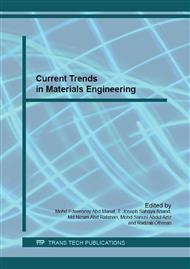p.3
p.8
p.13
p.18
p.23
p.29
p.34
p.39
Mechanical Properties and Failure Analysis of Laminated Glass Reinforced Composite with Various Gelcoat Thickness
Abstract:
The aim of this study is to evaluate the mechanical properties and study the failure of laminated glass reinforced composite coated with gelcoat of different thickness. Firstly, the gelcoat was applied to the mould using brush and subsequently, glass fiber reinforced composite laminates were fabricated on it using vacuum bagging technique. The mechanical properties of the composites various were tested by using tensile and three-point flexural tests. The fracture behaviour of different gelcoat thickness was observed using scanning electron microscope (SEM) to determine the failure behaviour that occurred. The flexural test was performed in two ways, i.e., gelcoat layer facing top and facing down. For both flexural tests, composite coated with 0.30 mm thick of gelcoat shows the highest mechanical strength. Tensile test is useful to investigate the interfacial bonding in between gelcoat and laminate composite. The composite coated with 0.40 mm of gelcoat showed the highest tensile strength, an increase of 38 % compared to the uncoated composite. It was observed that an increase in gelcoat thickness increased the brittleness of the laminated composite. From the failure analysis, failures were caused by the delamination of matrix between the plies, while the gelcoat was still strongly bonded with composite laminate.
Info:
Periodical:
Pages:
8-12
Citation:
Online since:
May 2016
Price:
Сopyright:
© 2016 Trans Tech Publications Ltd. All Rights Reserved
Share:
Citation:


